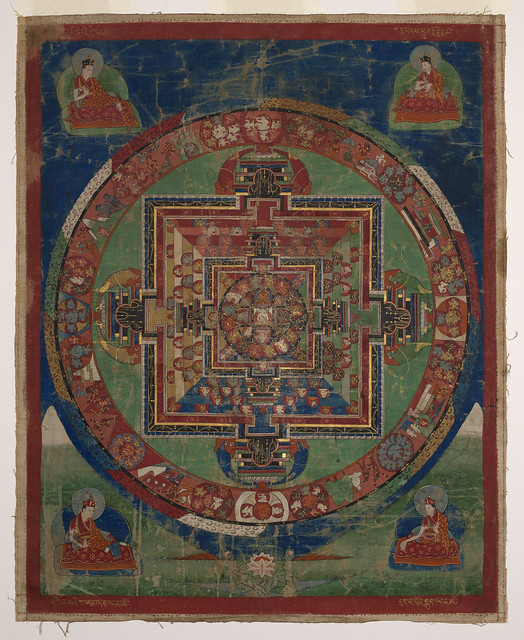
Mandala of the Luminous One, Nampar Nangdzé, Central Tibet, ca. 18th century, distemper on cloth, The Jack Shear Collection of Tibetan Art
Mastery and Merit: Tibetan Art from the Jack Shear Collection and
Beyond the Threshold: Tibetan Contemporary Art
Frances Lehman Loeb Art Center, Vassar College
Now on view through July 31
Vassar College's Frances Lehman Loeb Art Center currently has on display exhibitions of Tibetan traditional and contemporary art.
Drawn from the Jack Shear Collection, Mastery and Merit presents more than thirty works that demonstrate the multivalent and critical roles of Buddhist masters, as well as the rich diversity of merit-generating practices available to devotees. Displayed across three galleries and organized by Ariana Maki, Associate Director of the University of Virginia Tibet Center and Bhutan Initiative and lecturer in Art History and Religious Studies, the exhibition highlights multiple Tibetan Buddhist masters and reincarnation lineages; deities associated with everyday concerns like healing, wealth, and removing obstacles; and a selection of images associated with sophisticated, highly esoteric practices available to advanced initiates.
This exhibition marks the inaugural display of an innovative collaboration among three prominent college art museums—the collection of Tibetan art from the Jack Shear Collection has been gifted jointly to the Frances Young Tang Teaching Museum and Art Gallery at Skidmore College, the Frances Lehman Loeb Art Center at Vassar College, and the Williams College Museum of Art (WCMA). Subsequent presentations at WCMA and at the Tang Museum are planned for the spring 2023 and fall 2023 semesters respectively. Jack Shear is a photographer, curator, collector, and executive director of the Ellsworth Kelly Foundation with ongoing relationships with all three institutions.
Beyond the Threshold highlights the diversity of contemporary Tibetan creative expression, presenting works from ten artists based around the world. Born between the 1950s and 1990s, these artists are translating their experiences and insights for global audiences, driving Tibetan art into new territory by repurposing familiar imagery, providing commentary on consumer culture, and engaging social issues. Drawn from private collections and made available by the artists themselves, the objects are accompanied by bilingual English-Tibetan object labels, many of which incorporate quotes from the artists that convey the motivations and intentions behind their work.
Read more, click here
